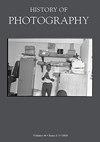美国的拉丁摄影:视觉史
IF 0.2
2区 艺术学
0 ART
引用次数: 0
摘要
在他的每一章中,关于所产生的知识,用来呈现图像的媒介,它的治疗目的,它被利用的公共或私人空间以及它被收集和保存的方式。构成摄影流动过程的“原材料的戏剧性”与被拍摄的面部伤口的戏剧性和流动性是一种持续的平行。通过追踪这些医学照片在各种档案和收藏中的移动,包括这些图像的现存复制品,以及它们传播的不同形式——印刷品、幻灯片、出版物等等——贝特让他的读者相信,这些图像“远非干燥、静态的最终印刷品”;他们有过多种生活,引发了许多伦理困境,影响了各种收集和意义创造的方法。有时,贝特的观点被不雅的文笔所掩盖。此外,《一战中的摄影》本可以从编辑团队的另一轮校对中受益,因为有反复出现的错别字问题。但是,总的来说,这本书为第一次世界大战中面部受伤的军人的形象增添了必要的制度、经济、文化和个人背景。贝特这样做时,并没有回避病人及其家属在创作和储存这些照片时的情感角色,也没有回避历史学家在观看和撰写这些照片时的道德不确定性。本文章由计算机程序翻译,如有差异,请以英文原文为准。
Latinx Photography in the United States: A Visual History
in each of his chapters, on the knowledge produced, the medium used to present the image, its therapeutic purpose, the public or private space in which it is utilised and the manner in which it is collected and saved. The ‘drama of the raw materials’ that make up the liquid process of photography is a constant parallel to the drama and the liquidity of the facial wounds that are being photographed. By tracing the movement of these medical photographs within various archives and collections, including the extant multiples of these images, and the different formats in which they were communicated – prints, lantern slides, publications and so on – Bate convinces his readers that these images ‘are far from dry, static final prints’; they have lived multiple lives, fomented many ethical quandaries and effected various methods of collection and meaning making. At times, Bate’s points are obscured by inelegant prose. Additionally, Photography in the Great War could have benefited from another round of proofreading from the editorial team, as there are recurring typo issues. But, overall, this book adds necessary institutional, economic, cultural and personal context to images of facially injured First World War servicemen. Bate does this without shying away from the emotional roles of the patients and their families in the creation and storage of these images, as well as the historian’s ethical uncertainties in viewing and writing about these photographs.
求助全文
通过发布文献求助,成功后即可免费获取论文全文。
去求助
来源期刊
CiteScore
0.30
自引率
50.00%
发文量
23
期刊介绍:
History of Photography is an international quarterly devoted to the history, practice and theory of photography. It intends to address all aspects of the medium, treating the processes, circulation, functions, and reception of photography in all its aspects, including documentary, popular and polemical work as well as fine art photography. The goal of the journal is to be inclusive and interdisciplinary in nature, welcoming all scholarly approaches, whether archival, historical, art historical, anthropological, sociological or theoretical. It is intended also to embrace world photography, ranging from Europe and the Americas to the Far East.

 求助内容:
求助内容: 应助结果提醒方式:
应助结果提醒方式:


